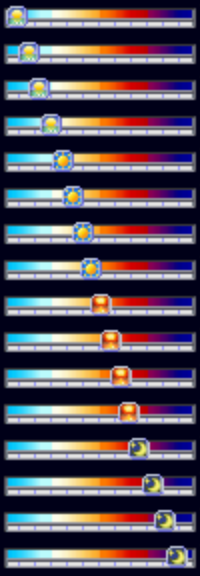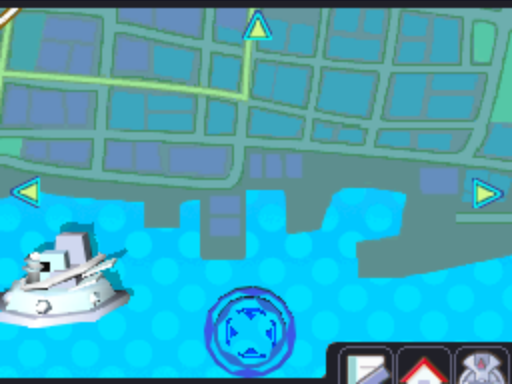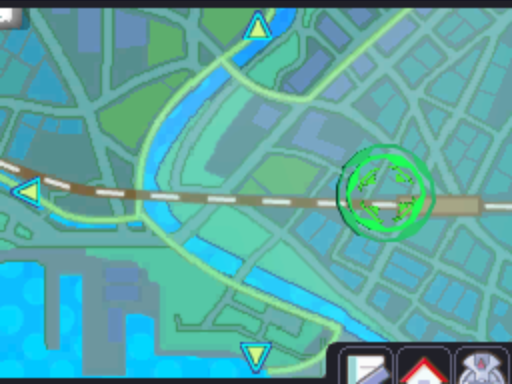NPC spawns in Yu-Gi-Oh! Nightmare Troubadour
In the previous post we looked at the details of how packs work in Yu-Gi-Oh! Nightmare Troubadour. In this post we’re going to look at how the game decides which NPCs to spawn, and a little about how the game places them on the map. Like the last post, this work was done on the PAL version of the game. I did have a quick peek at the corresponding data for the NTSC-U version though, because of the issue with Pegasus.
Overview
Yu-Gi-Oh! Nightmare Troubadour does not merely present the player with a list of opponents to duel at any time they wish. Instead, the opponents exist on an overworld and must be found by the player. This can be seen as an evolution of the system introduced in Duel Monsters 6: Expert 2.
The player moves a cursor around the city they’re in (past a certain point the player unlocks a second city). The cursor starts as blue, but when it gets close to an opponent it turns green. Closer still, it turns red. Finally when it’s very close the opponent will be detected and you have the option to face them. The amount of information you have on who an opponent is depends on details we need not go into here.
The opponents who have a chance of appearing depend on which of the two cities the player is in, what time of day it is (there is an in-game day/night cycle), and how far the player has progressed through the story. So first question, who can appear and when?
Who wants to play?
Time in Nightmare Troubadour is a value from 0 to 255. The symbol the game uses for time changes for each quarter of the day, but the game additionally subdivides each quarter into four smaller quarters. The sixteenth of the day affects which opponents can spawn.
 The earliest time of each sixteenth of the day
The earliest time of each sixteenth of the day
Progress through the story is represented by two values, a stage and a substage. The stage goes from zero to ten; the substage’s range of values depends on the current stage. I have not spent the time to work out the conditions that must be met to progress to the next stage or substage. Some educated guesses are possible, and I suspect the simplest way to work out the troublesome ones would be to experiment with savestates while looking at the relevant values. The stage is a two-byte value at 0x2097460, while the substage is the byte at 0x2097464.
Using these values, the game builds the list of opponents that can spawn subject to those conditions. I’ve put the data into this XML file. Each element has the time, stage, substage, and the city corresponding to the data.
The next important thing is the PRNG used. Like with packs, it’s an LCG, but it’s a different LCG. I have included an auxiliary method called randnum that gives a procedure the game often uses to generate a random number from 0 to upper_bound - 1 for some upper bound.
1
2
3
4
5
6
7
8
9
10
class Prng:
def __init__(self, seed):
self.__seed = seed
def rand(self):
self.__seed = (0x41C64E6D * self.__seed + 0x3039) & 0xFFFFFFFF
return (self.__seed >> 16) & 0x7FFF
def randnum(self, upper_bound):
return (self.rand() * upper_bound) // 32768
It appears the game initialises the seed with the number of frames elapsed since power-on when the player clicks on Continue. I haven’t thoroughly tested it but it doesn’t appear to be called every frame or anything like that, so manip should be very viable. Whether it’d be worthwhile is another matter.
With the PRNG set up, the game looks at a base count for the number of opponents to spawn. This only depends on the city, stage (not substage), and time, and is included in the XML as baseCount. The game generates a random number from 0 to baseCount - 3, then adds 3, so it’s a random number from 3 to baseCount. This is with the exception of the case where baseCount is 2, in which case it is instead always 3. This random number is meant to be how many opponents the game spawns.
If the number of opponents to spawn is at least as great as the possible number of opponents, the game spawns all of them. Otherwise it randomly selects the desired amount out of the list of possible opponents. For this purpose, each of the possible opponents comes with a ‘spawn rate’, and roughly speaking a higher spawn rate means a higher chance of the opponent being selected. Some Python giving how the game goes about the selection is given below.
1
2
3
4
5
6
7
8
9
10
11
12
13
14
15
16
17
18
19
20
def select_available_opponents(prng, opponent_list, base_count):
# opponent_list is an array of (opponent_name, spawn_rate)
count = prng.randnum(base_count - 2) + 3
if count >= len(opponent_list):
return [opp for opp, _ in opponent_list]
opponents = []
# This copy is so we can safely modify the local list
opponent_list = [x for x in opponent_list]
total_spawn_rate = sum(prob for _, prob in opponent_list)
while len(opponents) < count:
slot = prng.randnum(len(opponent_list))
while True:
character, char_prob = opponent_list[slot]
threshold = (char_prob * 100) // total_spawn_rate
if prng.randnum(100) < threshold:
break
slot = (slot + 1) % len(opponent_list)
opponents.append(character)
opponent_list = opponent_list[:slot] + opponent_list[slot+1:]
return opponents
Where shall we play?
This is only half of the puzzle. Once the game has decided who to spawn, the game then has to decide where on the map to place them. I have not worked out all the details of this process, but I have enough to be worth documenting.
The game goes through the spawned opponents in order of their ID, rather than the order returned from the above procedure. This order can be inferred from the XML, where the available opponents start ordered by their ID. For each one, the game generates a position for them. It does this by continually generating random points until it finds one far enough away from all previously placed opponents, the player, and it seems any visible buildings on the map. This includes the train station, card shop, the player’s home, the Duel Base, and probably places like the location of the Expert Cup finalists party and the building Serenity is taken to. There is an additional check on the generated location, which I believe is how the game makes sure to not spawn opponents in the middle of the sea.
 Poseidon does not care to duel you
Poseidon does not care to duel you
The function that keeps generating a random point until a valid one is found is called FUN_overlay_d_15__022630c0 by Ghidra, in case anyone wishes to investigate further.
Loose ends: passersby and Shadow Games
I have not looked much into passersby or duelists who intercept you and force you into a Shadow Game, but it probably isn’t complicated. For passersby, it appears the game may add one after assigning a position to all spawned duelists, with a spawn rate of 0%, 20%, or 100%. If one is spawned, they are assigned a position the same way duelists are.
In the function that takes care of selecting which opponents to spawn, there is a branch for the case where the game wants to spawn an opponent to challenge you to a Shadow Game. It goes the same as select_available_opponents usually does, except count will always be one and not consult base_count. Here is a similar XML for such opponents.
Pegasus
It is well-known amongst players of Nightmare Troubadour that there is a bug preventing Pegasus from spawning in the NTSC versions once Odion has been defeated for the first time. This means that if not already obtained, the player is locked out of Pegasus’ Deck Recipe. Furthermore, since Imperial Order is a postgame trade, it is impossible to obtain a copy legitimately with just an NTSC-U copy of the game.
I had a quick glance at the corresponding code for the NTSC-U version and found no relevant differences. However, there are differences in the data giving which opponents can spawn and therein lies the answer. I have placed the NTSC-U data here for convenience. The only difference is Pegasus is not listed as spawning in stage ten at all, and in any city/time/substage combination in which he spawns in stage ten, he is removed and baseCount is one lower. As a curious consequence, note that this still means that he is not present for stage nine, which is probably from after the player first defeats Odion up until Yami Marik is defeated.
There is no difference in the data for opponents who intercept the player and force them into a Shadow Game.
